1803NRS: Influences Shaping Australian Healthcare Access Essay
VerifiedAdded on 2023/03/20
|9
|2359
|65
Essay
AI Summary
This essay delves into the complex influences shaping healthcare access in Australia, focusing on socioeconomic status and equity issues. It examines how factors such as income, education, and political disparities impact access to healthcare, particularly highlighting the challenges faced by low and middle-class Australians and the indigenous population. The essay explores the consequences of these influences, including disparities in healthcare quality, limited access to resources, and the impact on the roles of registered nurses. Furthermore, it discusses the implications of health inequality, particularly in the context of indigenous Australians' lower life expectancy and higher rates of health risk behaviors. The analysis underscores the need for policy changes to address these inequalities and ensure equitable healthcare access for all Australians, irrespective of their socioeconomic status or race. The essay concludes by emphasizing the critical role of nurses in navigating these challenges and advocating for improved healthcare facilities and services, especially in public hospitals.
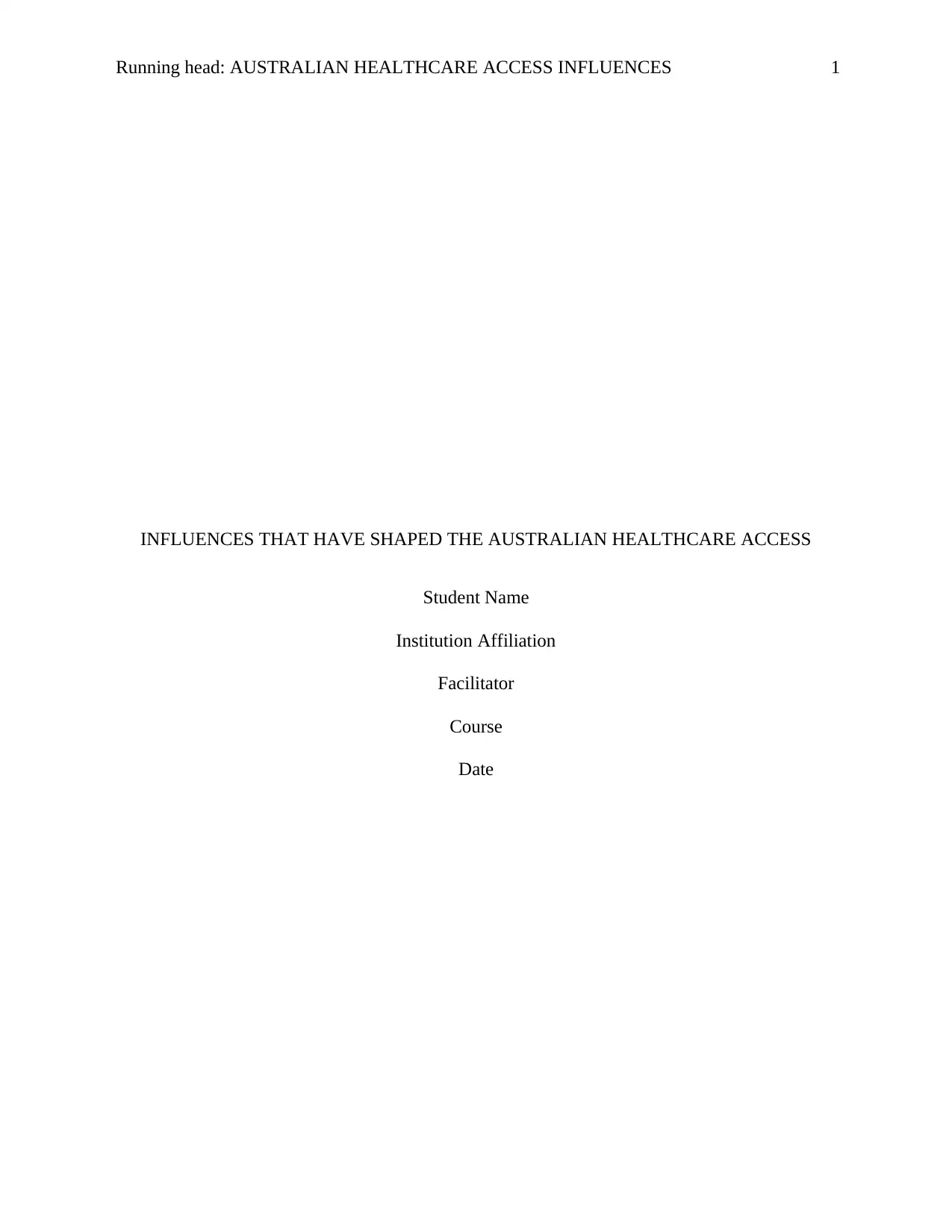
Running head: AUSTRALIAN HEALTHCARE ACCESS INFLUENCES 1
INFLUENCES THAT HAVE SHAPED THE AUSTRALIAN HEALTHCARE ACCESS
Student Name
Institution Affiliation
Facilitator
Course
Date
INFLUENCES THAT HAVE SHAPED THE AUSTRALIAN HEALTHCARE ACCESS
Student Name
Institution Affiliation
Facilitator
Course
Date
Paraphrase This Document
Need a fresh take? Get an instant paraphrase of this document with our AI Paraphraser
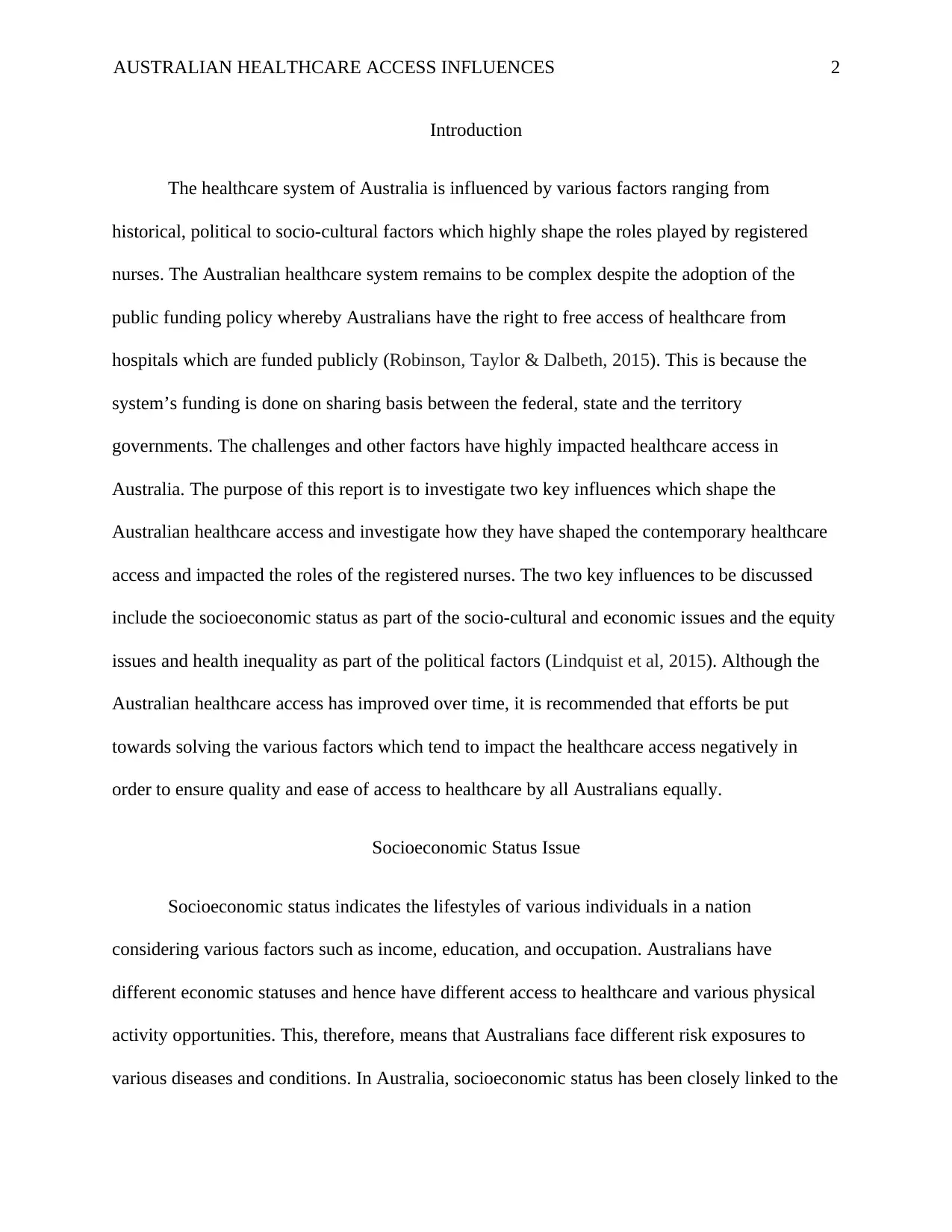
AUSTRALIAN HEALTHCARE ACCESS INFLUENCES 2
Introduction
The healthcare system of Australia is influenced by various factors ranging from
historical, political to socio-cultural factors which highly shape the roles played by registered
nurses. The Australian healthcare system remains to be complex despite the adoption of the
public funding policy whereby Australians have the right to free access of healthcare from
hospitals which are funded publicly (Robinson, Taylor & Dalbeth, 2015). This is because the
system’s funding is done on sharing basis between the federal, state and the territory
governments. The challenges and other factors have highly impacted healthcare access in
Australia. The purpose of this report is to investigate two key influences which shape the
Australian healthcare access and investigate how they have shaped the contemporary healthcare
access and impacted the roles of the registered nurses. The two key influences to be discussed
include the socioeconomic status as part of the socio-cultural and economic issues and the equity
issues and health inequality as part of the political factors (Lindquist et al, 2015). Although the
Australian healthcare access has improved over time, it is recommended that efforts be put
towards solving the various factors which tend to impact the healthcare access negatively in
order to ensure quality and ease of access to healthcare by all Australians equally.
Socioeconomic Status Issue
Socioeconomic status indicates the lifestyles of various individuals in a nation
considering various factors such as income, education, and occupation. Australians have
different economic statuses and hence have different access to healthcare and various physical
activity opportunities. This, therefore, means that Australians face different risk exposures to
various diseases and conditions. In Australia, socioeconomic status has been closely linked to the
Introduction
The healthcare system of Australia is influenced by various factors ranging from
historical, political to socio-cultural factors which highly shape the roles played by registered
nurses. The Australian healthcare system remains to be complex despite the adoption of the
public funding policy whereby Australians have the right to free access of healthcare from
hospitals which are funded publicly (Robinson, Taylor & Dalbeth, 2015). This is because the
system’s funding is done on sharing basis between the federal, state and the territory
governments. The challenges and other factors have highly impacted healthcare access in
Australia. The purpose of this report is to investigate two key influences which shape the
Australian healthcare access and investigate how they have shaped the contemporary healthcare
access and impacted the roles of the registered nurses. The two key influences to be discussed
include the socioeconomic status as part of the socio-cultural and economic issues and the equity
issues and health inequality as part of the political factors (Lindquist et al, 2015). Although the
Australian healthcare access has improved over time, it is recommended that efforts be put
towards solving the various factors which tend to impact the healthcare access negatively in
order to ensure quality and ease of access to healthcare by all Australians equally.
Socioeconomic Status Issue
Socioeconomic status indicates the lifestyles of various individuals in a nation
considering various factors such as income, education, and occupation. Australians have
different economic statuses and hence have different access to healthcare and various physical
activity opportunities. This, therefore, means that Australians face different risk exposures to
various diseases and conditions. In Australia, socioeconomic status has been closely linked to the
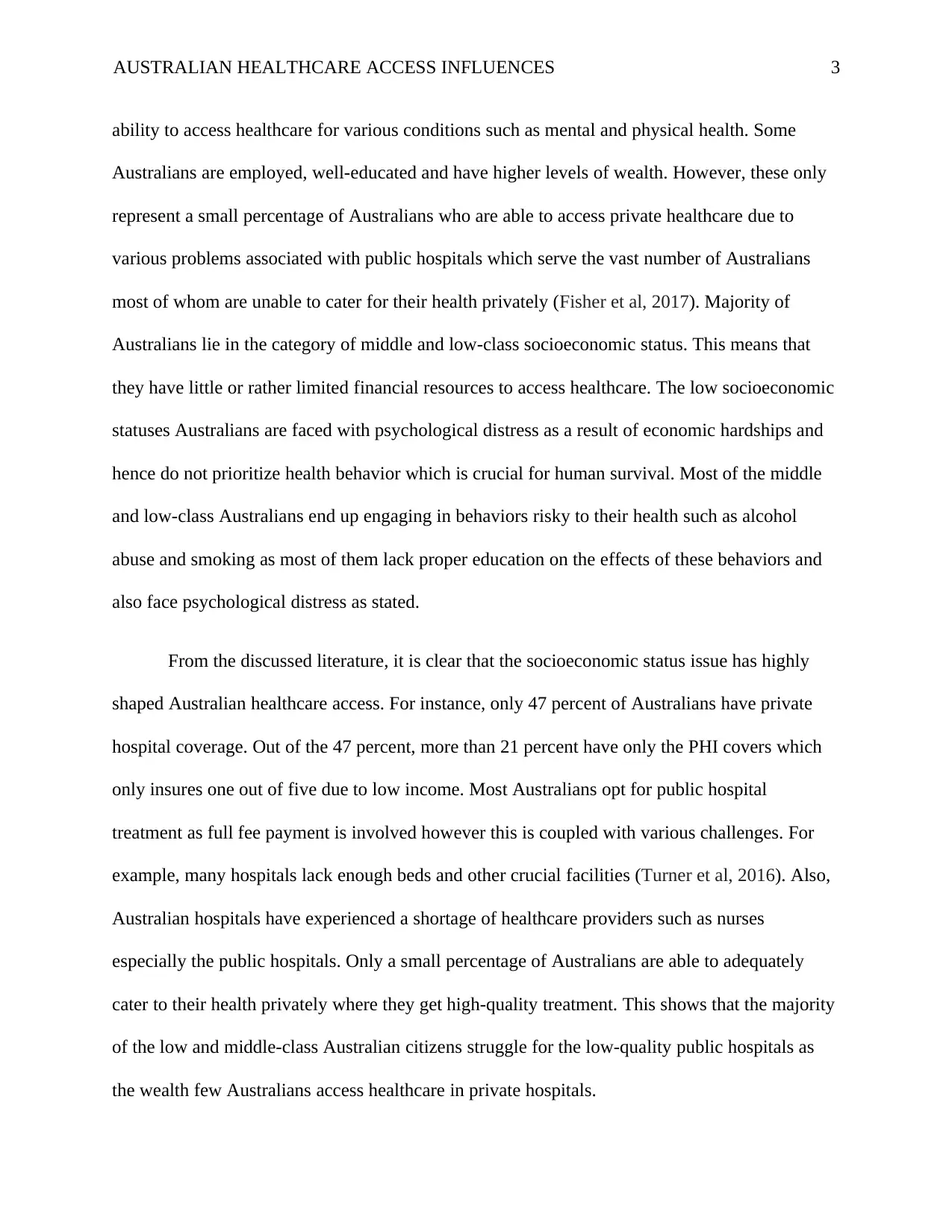
AUSTRALIAN HEALTHCARE ACCESS INFLUENCES 3
ability to access healthcare for various conditions such as mental and physical health. Some
Australians are employed, well-educated and have higher levels of wealth. However, these only
represent a small percentage of Australians who are able to access private healthcare due to
various problems associated with public hospitals which serve the vast number of Australians
most of whom are unable to cater for their health privately (Fisher et al, 2017). Majority of
Australians lie in the category of middle and low-class socioeconomic status. This means that
they have little or rather limited financial resources to access healthcare. The low socioeconomic
statuses Australians are faced with psychological distress as a result of economic hardships and
hence do not prioritize health behavior which is crucial for human survival. Most of the middle
and low-class Australians end up engaging in behaviors risky to their health such as alcohol
abuse and smoking as most of them lack proper education on the effects of these behaviors and
also face psychological distress as stated.
From the discussed literature, it is clear that the socioeconomic status issue has highly
shaped Australian healthcare access. For instance, only 47 percent of Australians have private
hospital coverage. Out of the 47 percent, more than 21 percent have only the PHI covers which
only insures one out of five due to low income. Most Australians opt for public hospital
treatment as full fee payment is involved however this is coupled with various challenges. For
example, many hospitals lack enough beds and other crucial facilities (Turner et al, 2016). Also,
Australian hospitals have experienced a shortage of healthcare providers such as nurses
especially the public hospitals. Only a small percentage of Australians are able to adequately
cater to their health privately where they get high-quality treatment. This shows that the majority
of the low and middle-class Australian citizens struggle for the low-quality public hospitals as
the wealth few Australians access healthcare in private hospitals.
ability to access healthcare for various conditions such as mental and physical health. Some
Australians are employed, well-educated and have higher levels of wealth. However, these only
represent a small percentage of Australians who are able to access private healthcare due to
various problems associated with public hospitals which serve the vast number of Australians
most of whom are unable to cater for their health privately (Fisher et al, 2017). Majority of
Australians lie in the category of middle and low-class socioeconomic status. This means that
they have little or rather limited financial resources to access healthcare. The low socioeconomic
statuses Australians are faced with psychological distress as a result of economic hardships and
hence do not prioritize health behavior which is crucial for human survival. Most of the middle
and low-class Australians end up engaging in behaviors risky to their health such as alcohol
abuse and smoking as most of them lack proper education on the effects of these behaviors and
also face psychological distress as stated.
From the discussed literature, it is clear that the socioeconomic status issue has highly
shaped Australian healthcare access. For instance, only 47 percent of Australians have private
hospital coverage. Out of the 47 percent, more than 21 percent have only the PHI covers which
only insures one out of five due to low income. Most Australians opt for public hospital
treatment as full fee payment is involved however this is coupled with various challenges. For
example, many hospitals lack enough beds and other crucial facilities (Turner et al, 2016). Also,
Australian hospitals have experienced a shortage of healthcare providers such as nurses
especially the public hospitals. Only a small percentage of Australians are able to adequately
cater to their health privately where they get high-quality treatment. This shows that the majority
of the low and middle-class Australian citizens struggle for the low-quality public hospitals as
the wealth few Australians access healthcare in private hospitals.
⊘ This is a preview!⊘
Do you want full access?
Subscribe today to unlock all pages.

Trusted by 1+ million students worldwide
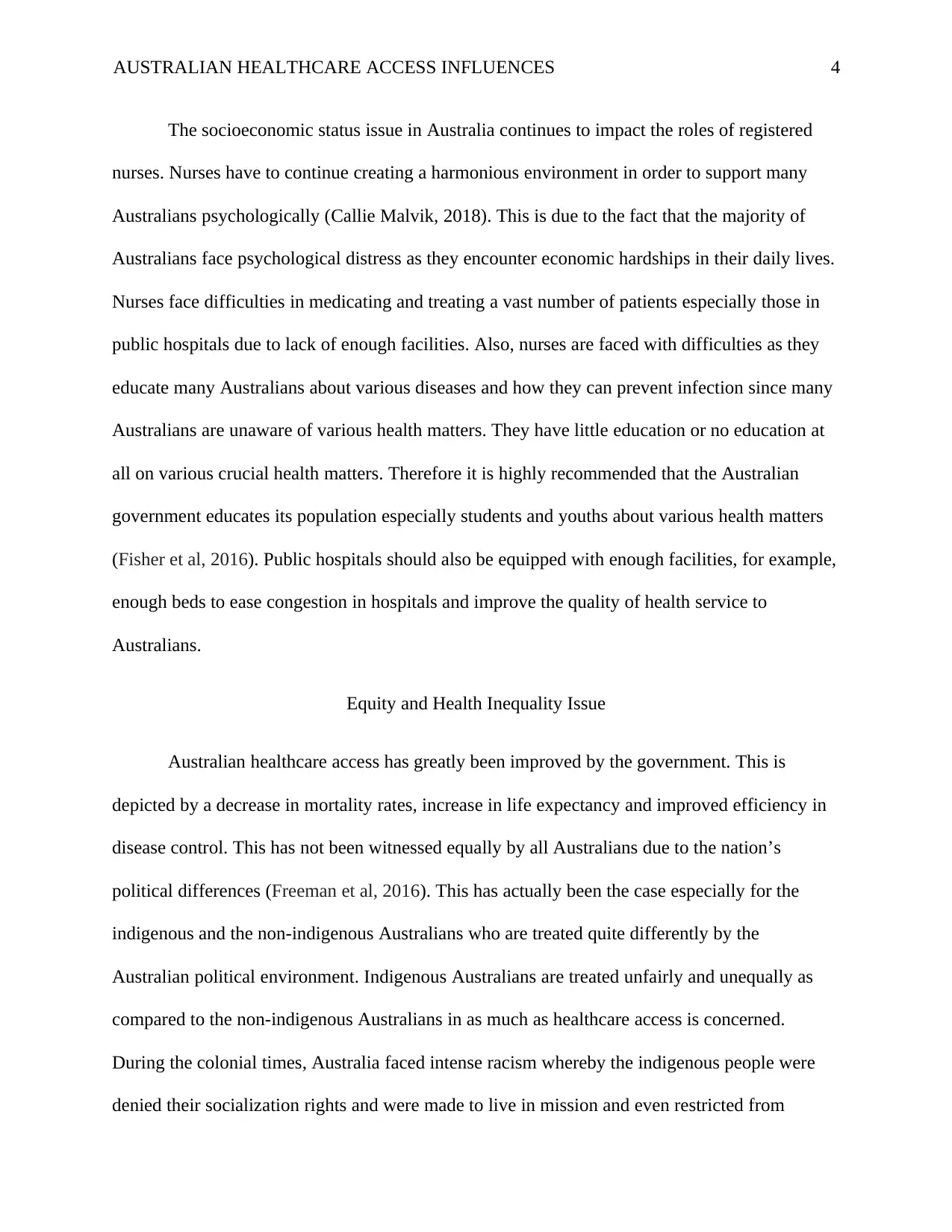
AUSTRALIAN HEALTHCARE ACCESS INFLUENCES 4
The socioeconomic status issue in Australia continues to impact the roles of registered
nurses. Nurses have to continue creating a harmonious environment in order to support many
Australians psychologically (Callie Malvik, 2018). This is due to the fact that the majority of
Australians face psychological distress as they encounter economic hardships in their daily lives.
Nurses face difficulties in medicating and treating a vast number of patients especially those in
public hospitals due to lack of enough facilities. Also, nurses are faced with difficulties as they
educate many Australians about various diseases and how they can prevent infection since many
Australians are unaware of various health matters. They have little education or no education at
all on various crucial health matters. Therefore it is highly recommended that the Australian
government educates its population especially students and youths about various health matters
(Fisher et al, 2016). Public hospitals should also be equipped with enough facilities, for example,
enough beds to ease congestion in hospitals and improve the quality of health service to
Australians.
Equity and Health Inequality Issue
Australian healthcare access has greatly been improved by the government. This is
depicted by a decrease in mortality rates, increase in life expectancy and improved efficiency in
disease control. This has not been witnessed equally by all Australians due to the nation’s
political differences (Freeman et al, 2016). This has actually been the case especially for the
indigenous and the non-indigenous Australians who are treated quite differently by the
Australian political environment. Indigenous Australians are treated unfairly and unequally as
compared to the non-indigenous Australians in as much as healthcare access is concerned.
During the colonial times, Australia faced intense racism whereby the indigenous people were
denied their socialization rights and were made to live in mission and even restricted from
The socioeconomic status issue in Australia continues to impact the roles of registered
nurses. Nurses have to continue creating a harmonious environment in order to support many
Australians psychologically (Callie Malvik, 2018). This is due to the fact that the majority of
Australians face psychological distress as they encounter economic hardships in their daily lives.
Nurses face difficulties in medicating and treating a vast number of patients especially those in
public hospitals due to lack of enough facilities. Also, nurses are faced with difficulties as they
educate many Australians about various diseases and how they can prevent infection since many
Australians are unaware of various health matters. They have little education or no education at
all on various crucial health matters. Therefore it is highly recommended that the Australian
government educates its population especially students and youths about various health matters
(Fisher et al, 2016). Public hospitals should also be equipped with enough facilities, for example,
enough beds to ease congestion in hospitals and improve the quality of health service to
Australians.
Equity and Health Inequality Issue
Australian healthcare access has greatly been improved by the government. This is
depicted by a decrease in mortality rates, increase in life expectancy and improved efficiency in
disease control. This has not been witnessed equally by all Australians due to the nation’s
political differences (Freeman et al, 2016). This has actually been the case especially for the
indigenous and the non-indigenous Australians who are treated quite differently by the
Australian political environment. Indigenous Australians are treated unfairly and unequally as
compared to the non-indigenous Australians in as much as healthcare access is concerned.
During the colonial times, Australia faced intense racism whereby the indigenous people were
denied their socialization rights and were made to live in mission and even restricted from
Paraphrase This Document
Need a fresh take? Get an instant paraphrase of this document with our AI Paraphraser
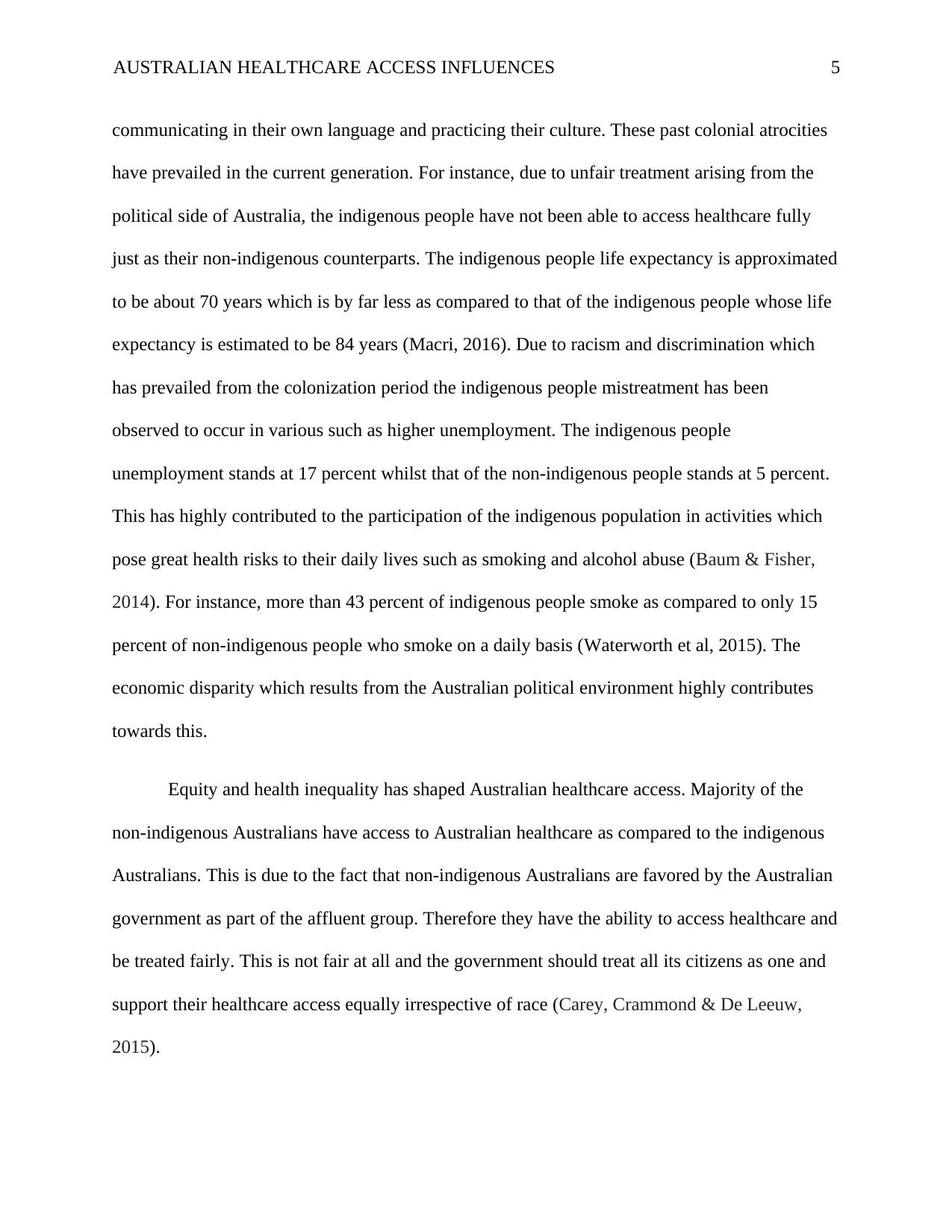
AUSTRALIAN HEALTHCARE ACCESS INFLUENCES 5
communicating in their own language and practicing their culture. These past colonial atrocities
have prevailed in the current generation. For instance, due to unfair treatment arising from the
political side of Australia, the indigenous people have not been able to access healthcare fully
just as their non-indigenous counterparts. The indigenous people life expectancy is approximated
to be about 70 years which is by far less as compared to that of the indigenous people whose life
expectancy is estimated to be 84 years (Macri, 2016). Due to racism and discrimination which
has prevailed from the colonization period the indigenous people mistreatment has been
observed to occur in various such as higher unemployment. The indigenous people
unemployment stands at 17 percent whilst that of the non-indigenous people stands at 5 percent.
This has highly contributed to the participation of the indigenous population in activities which
pose great health risks to their daily lives such as smoking and alcohol abuse (Baum & Fisher,
2014). For instance, more than 43 percent of indigenous people smoke as compared to only 15
percent of non-indigenous people who smoke on a daily basis (Waterworth et al, 2015). The
economic disparity which results from the Australian political environment highly contributes
towards this.
Equity and health inequality has shaped Australian healthcare access. Majority of the
non-indigenous Australians have access to Australian healthcare as compared to the indigenous
Australians. This is due to the fact that non-indigenous Australians are favored by the Australian
government as part of the affluent group. Therefore they have the ability to access healthcare and
be treated fairly. This is not fair at all and the government should treat all its citizens as one and
support their healthcare access equally irrespective of race (Carey, Crammond & De Leeuw,
2015).
communicating in their own language and practicing their culture. These past colonial atrocities
have prevailed in the current generation. For instance, due to unfair treatment arising from the
political side of Australia, the indigenous people have not been able to access healthcare fully
just as their non-indigenous counterparts. The indigenous people life expectancy is approximated
to be about 70 years which is by far less as compared to that of the indigenous people whose life
expectancy is estimated to be 84 years (Macri, 2016). Due to racism and discrimination which
has prevailed from the colonization period the indigenous people mistreatment has been
observed to occur in various such as higher unemployment. The indigenous people
unemployment stands at 17 percent whilst that of the non-indigenous people stands at 5 percent.
This has highly contributed to the participation of the indigenous population in activities which
pose great health risks to their daily lives such as smoking and alcohol abuse (Baum & Fisher,
2014). For instance, more than 43 percent of indigenous people smoke as compared to only 15
percent of non-indigenous people who smoke on a daily basis (Waterworth et al, 2015). The
economic disparity which results from the Australian political environment highly contributes
towards this.
Equity and health inequality has shaped Australian healthcare access. Majority of the
non-indigenous Australians have access to Australian healthcare as compared to the indigenous
Australians. This is due to the fact that non-indigenous Australians are favored by the Australian
government as part of the affluent group. Therefore they have the ability to access healthcare and
be treated fairly. This is not fair at all and the government should treat all its citizens as one and
support their healthcare access equally irrespective of race (Carey, Crammond & De Leeuw,
2015).
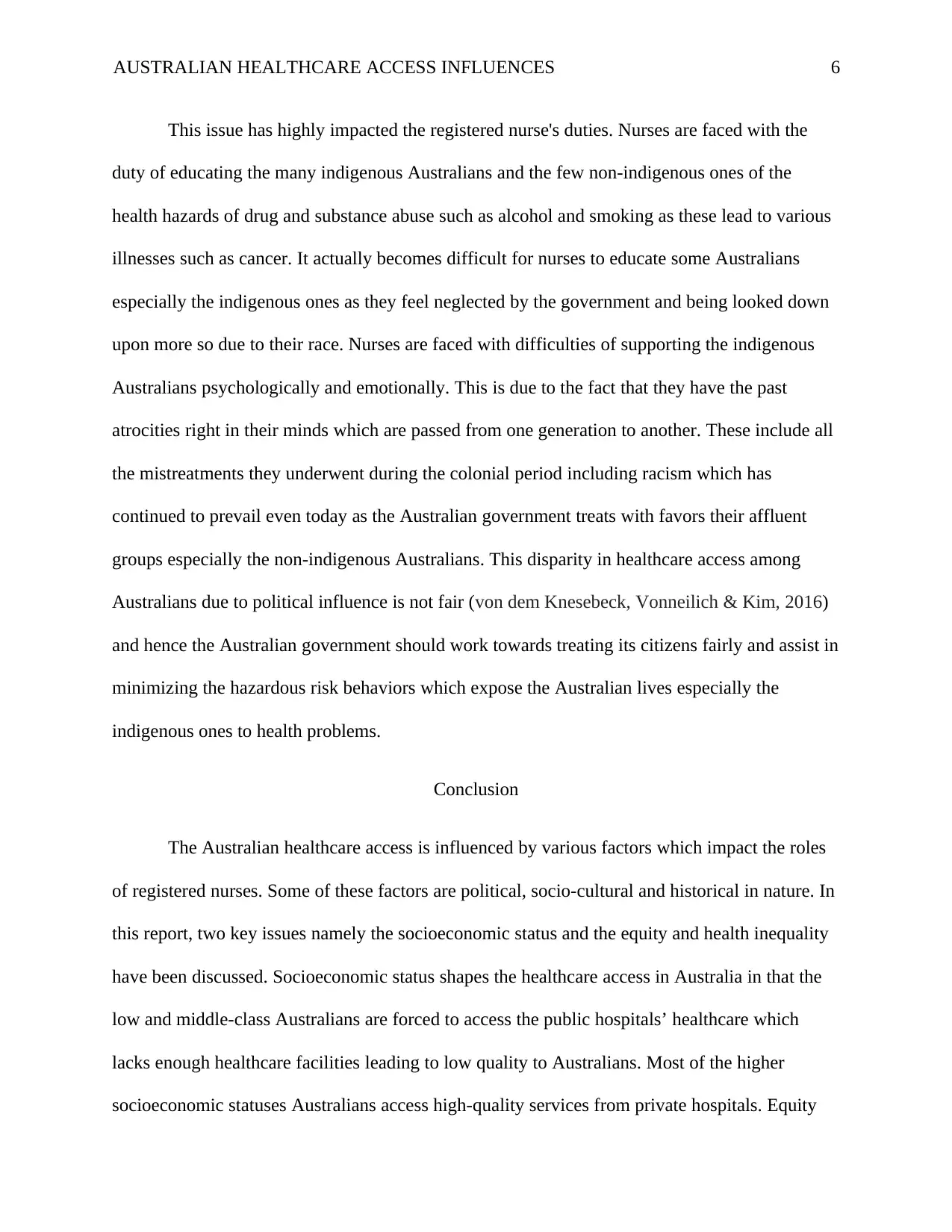
AUSTRALIAN HEALTHCARE ACCESS INFLUENCES 6
This issue has highly impacted the registered nurse's duties. Nurses are faced with the
duty of educating the many indigenous Australians and the few non-indigenous ones of the
health hazards of drug and substance abuse such as alcohol and smoking as these lead to various
illnesses such as cancer. It actually becomes difficult for nurses to educate some Australians
especially the indigenous ones as they feel neglected by the government and being looked down
upon more so due to their race. Nurses are faced with difficulties of supporting the indigenous
Australians psychologically and emotionally. This is due to the fact that they have the past
atrocities right in their minds which are passed from one generation to another. These include all
the mistreatments they underwent during the colonial period including racism which has
continued to prevail even today as the Australian government treats with favors their affluent
groups especially the non-indigenous Australians. This disparity in healthcare access among
Australians due to political influence is not fair (von dem Knesebeck, Vonneilich & Kim, 2016)
and hence the Australian government should work towards treating its citizens fairly and assist in
minimizing the hazardous risk behaviors which expose the Australian lives especially the
indigenous ones to health problems.
Conclusion
The Australian healthcare access is influenced by various factors which impact the roles
of registered nurses. Some of these factors are political, socio-cultural and historical in nature. In
this report, two key issues namely the socioeconomic status and the equity and health inequality
have been discussed. Socioeconomic status shapes the healthcare access in Australia in that the
low and middle-class Australians are forced to access the public hospitals’ healthcare which
lacks enough healthcare facilities leading to low quality to Australians. Most of the higher
socioeconomic statuses Australians access high-quality services from private hospitals. Equity
This issue has highly impacted the registered nurse's duties. Nurses are faced with the
duty of educating the many indigenous Australians and the few non-indigenous ones of the
health hazards of drug and substance abuse such as alcohol and smoking as these lead to various
illnesses such as cancer. It actually becomes difficult for nurses to educate some Australians
especially the indigenous ones as they feel neglected by the government and being looked down
upon more so due to their race. Nurses are faced with difficulties of supporting the indigenous
Australians psychologically and emotionally. This is due to the fact that they have the past
atrocities right in their minds which are passed from one generation to another. These include all
the mistreatments they underwent during the colonial period including racism which has
continued to prevail even today as the Australian government treats with favors their affluent
groups especially the non-indigenous Australians. This disparity in healthcare access among
Australians due to political influence is not fair (von dem Knesebeck, Vonneilich & Kim, 2016)
and hence the Australian government should work towards treating its citizens fairly and assist in
minimizing the hazardous risk behaviors which expose the Australian lives especially the
indigenous ones to health problems.
Conclusion
The Australian healthcare access is influenced by various factors which impact the roles
of registered nurses. Some of these factors are political, socio-cultural and historical in nature. In
this report, two key issues namely the socioeconomic status and the equity and health inequality
have been discussed. Socioeconomic status shapes the healthcare access in Australia in that the
low and middle-class Australians are forced to access the public hospitals’ healthcare which
lacks enough healthcare facilities leading to low quality to Australians. Most of the higher
socioeconomic statuses Australians access high-quality services from private hospitals. Equity
⊘ This is a preview!⊘
Do you want full access?
Subscribe today to unlock all pages.

Trusted by 1+ million students worldwide
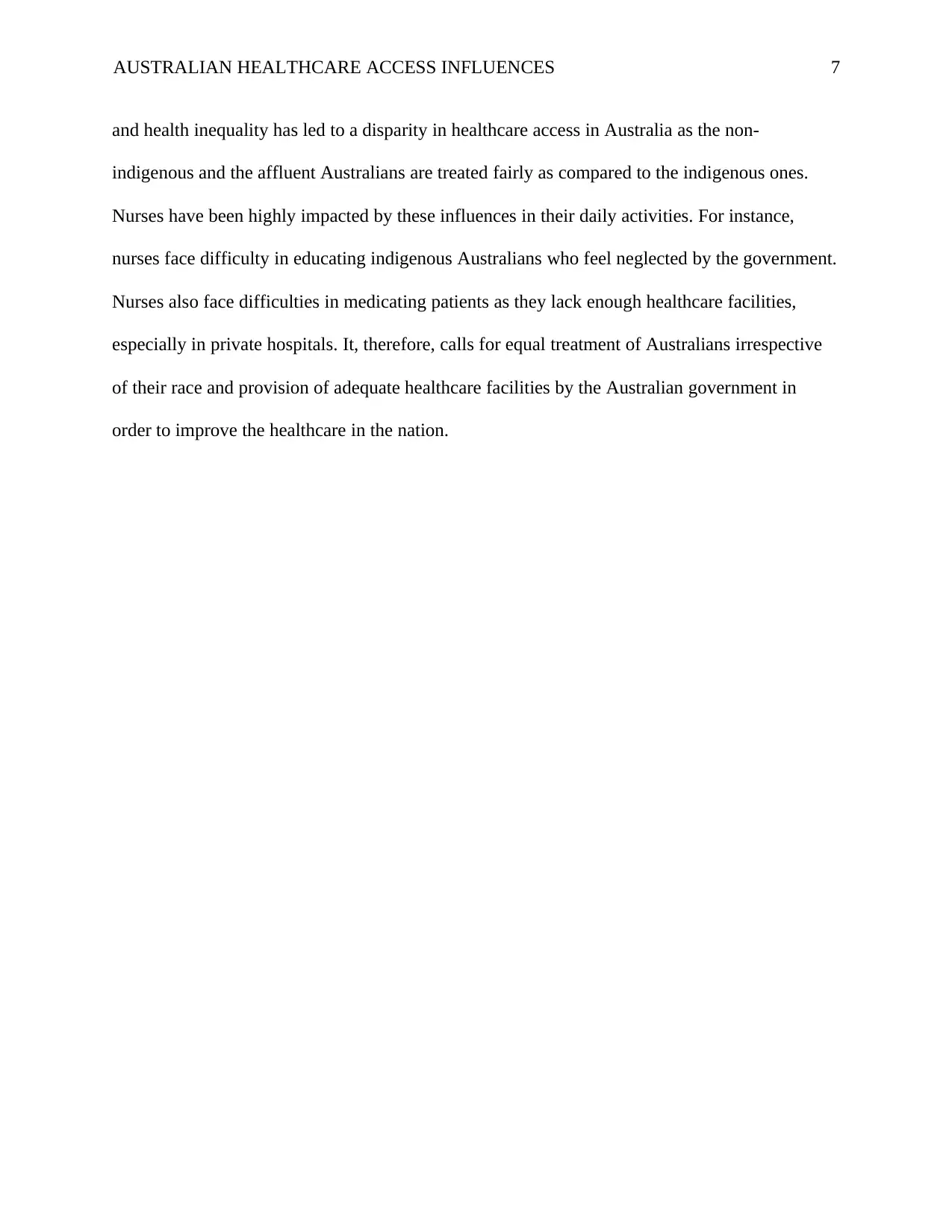
AUSTRALIAN HEALTHCARE ACCESS INFLUENCES 7
and health inequality has led to a disparity in healthcare access in Australia as the non-
indigenous and the affluent Australians are treated fairly as compared to the indigenous ones.
Nurses have been highly impacted by these influences in their daily activities. For instance,
nurses face difficulty in educating indigenous Australians who feel neglected by the government.
Nurses also face difficulties in medicating patients as they lack enough healthcare facilities,
especially in private hospitals. It, therefore, calls for equal treatment of Australians irrespective
of their race and provision of adequate healthcare facilities by the Australian government in
order to improve the healthcare in the nation.
and health inequality has led to a disparity in healthcare access in Australia as the non-
indigenous and the affluent Australians are treated fairly as compared to the indigenous ones.
Nurses have been highly impacted by these influences in their daily activities. For instance,
nurses face difficulty in educating indigenous Australians who feel neglected by the government.
Nurses also face difficulties in medicating patients as they lack enough healthcare facilities,
especially in private hospitals. It, therefore, calls for equal treatment of Australians irrespective
of their race and provision of adequate healthcare facilities by the Australian government in
order to improve the healthcare in the nation.
Paraphrase This Document
Need a fresh take? Get an instant paraphrase of this document with our AI Paraphraser
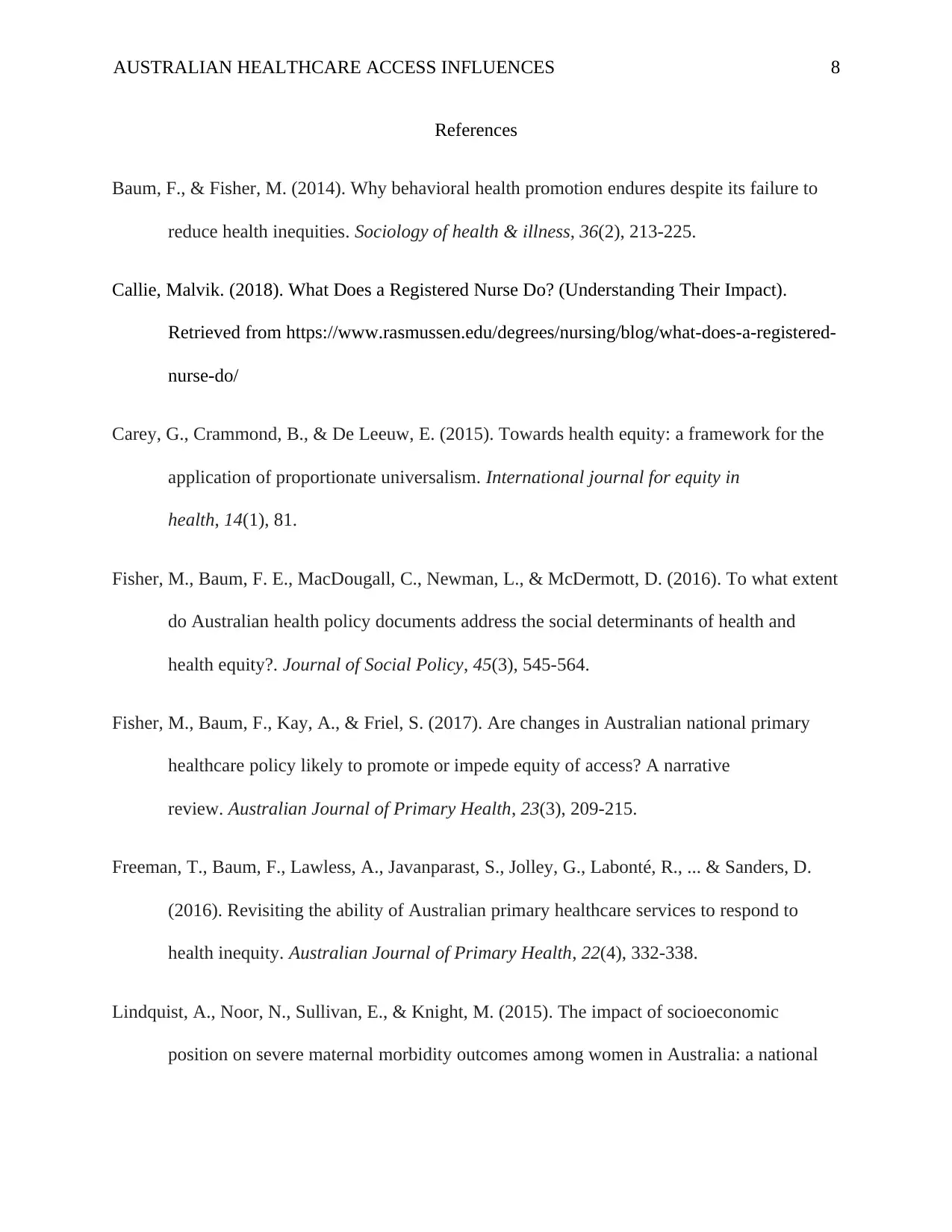
AUSTRALIAN HEALTHCARE ACCESS INFLUENCES 8
References
Baum, F., & Fisher, M. (2014). Why behavioral health promotion endures despite its failure to
reduce health inequities. Sociology of health & illness, 36(2), 213-225.
Callie, Malvik. (2018). What Does a Registered Nurse Do? (Understanding Their Impact).
Retrieved from https://www.rasmussen.edu/degrees/nursing/blog/what-does-a-registered-
nurse-do/
Carey, G., Crammond, B., & De Leeuw, E. (2015). Towards health equity: a framework for the
application of proportionate universalism. International journal for equity in
health, 14(1), 81.
Fisher, M., Baum, F. E., MacDougall, C., Newman, L., & McDermott, D. (2016). To what extent
do Australian health policy documents address the social determinants of health and
health equity?. Journal of Social Policy, 45(3), 545-564.
Fisher, M., Baum, F., Kay, A., & Friel, S. (2017). Are changes in Australian national primary
healthcare policy likely to promote or impede equity of access? A narrative
review. Australian Journal of Primary Health, 23(3), 209-215.
Freeman, T., Baum, F., Lawless, A., Javanparast, S., Jolley, G., Labonté, R., ... & Sanders, D.
(2016). Revisiting the ability of Australian primary healthcare services to respond to
health inequity. Australian Journal of Primary Health, 22(4), 332-338.
Lindquist, A., Noor, N., Sullivan, E., & Knight, M. (2015). The impact of socioeconomic
position on severe maternal morbidity outcomes among women in Australia: a national
References
Baum, F., & Fisher, M. (2014). Why behavioral health promotion endures despite its failure to
reduce health inequities. Sociology of health & illness, 36(2), 213-225.
Callie, Malvik. (2018). What Does a Registered Nurse Do? (Understanding Their Impact).
Retrieved from https://www.rasmussen.edu/degrees/nursing/blog/what-does-a-registered-
nurse-do/
Carey, G., Crammond, B., & De Leeuw, E. (2015). Towards health equity: a framework for the
application of proportionate universalism. International journal for equity in
health, 14(1), 81.
Fisher, M., Baum, F. E., MacDougall, C., Newman, L., & McDermott, D. (2016). To what extent
do Australian health policy documents address the social determinants of health and
health equity?. Journal of Social Policy, 45(3), 545-564.
Fisher, M., Baum, F., Kay, A., & Friel, S. (2017). Are changes in Australian national primary
healthcare policy likely to promote or impede equity of access? A narrative
review. Australian Journal of Primary Health, 23(3), 209-215.
Freeman, T., Baum, F., Lawless, A., Javanparast, S., Jolley, G., Labonté, R., ... & Sanders, D.
(2016). Revisiting the ability of Australian primary healthcare services to respond to
health inequity. Australian Journal of Primary Health, 22(4), 332-338.
Lindquist, A., Noor, N., Sullivan, E., & Knight, M. (2015). The impact of socioeconomic
position on severe maternal morbidity outcomes among women in Australia: a national
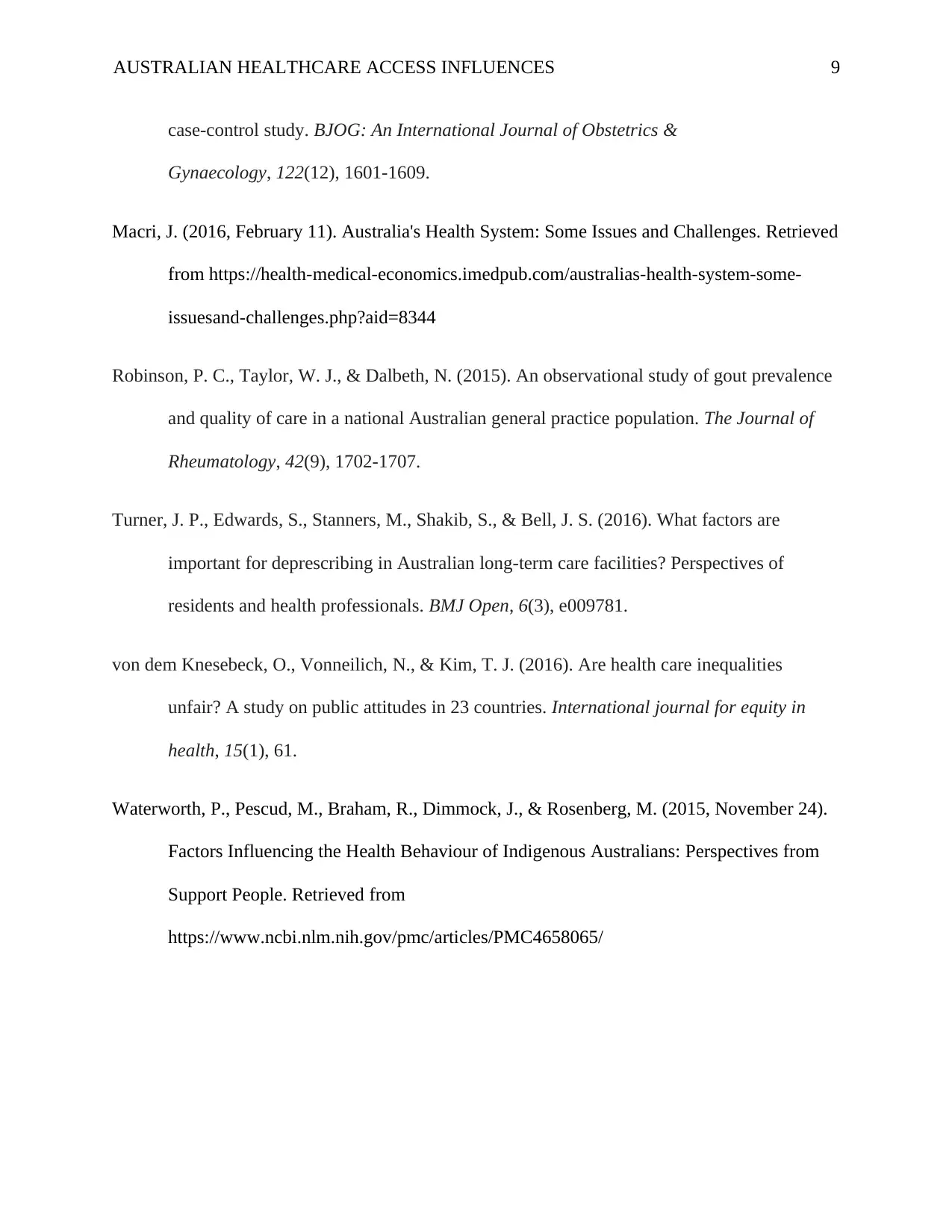
AUSTRALIAN HEALTHCARE ACCESS INFLUENCES 9
case-control study. BJOG: An International Journal of Obstetrics &
Gynaecology, 122(12), 1601-1609.
Macri, J. (2016, February 11). Australia's Health System: Some Issues and Challenges. Retrieved
from https://health-medical-economics.imedpub.com/australias-health-system-some-
issuesand-challenges.php?aid=8344
Robinson, P. C., Taylor, W. J., & Dalbeth, N. (2015). An observational study of gout prevalence
and quality of care in a national Australian general practice population. The Journal of
Rheumatology, 42(9), 1702-1707.
Turner, J. P., Edwards, S., Stanners, M., Shakib, S., & Bell, J. S. (2016). What factors are
important for deprescribing in Australian long-term care facilities? Perspectives of
residents and health professionals. BMJ Open, 6(3), e009781.
von dem Knesebeck, O., Vonneilich, N., & Kim, T. J. (2016). Are health care inequalities
unfair? A study on public attitudes in 23 countries. International journal for equity in
health, 15(1), 61.
Waterworth, P., Pescud, M., Braham, R., Dimmock, J., & Rosenberg, M. (2015, November 24).
Factors Influencing the Health Behaviour of Indigenous Australians: Perspectives from
Support People. Retrieved from
https://www.ncbi.nlm.nih.gov/pmc/articles/PMC4658065/
case-control study. BJOG: An International Journal of Obstetrics &
Gynaecology, 122(12), 1601-1609.
Macri, J. (2016, February 11). Australia's Health System: Some Issues and Challenges. Retrieved
from https://health-medical-economics.imedpub.com/australias-health-system-some-
issuesand-challenges.php?aid=8344
Robinson, P. C., Taylor, W. J., & Dalbeth, N. (2015). An observational study of gout prevalence
and quality of care in a national Australian general practice population. The Journal of
Rheumatology, 42(9), 1702-1707.
Turner, J. P., Edwards, S., Stanners, M., Shakib, S., & Bell, J. S. (2016). What factors are
important for deprescribing in Australian long-term care facilities? Perspectives of
residents and health professionals. BMJ Open, 6(3), e009781.
von dem Knesebeck, O., Vonneilich, N., & Kim, T. J. (2016). Are health care inequalities
unfair? A study on public attitudes in 23 countries. International journal for equity in
health, 15(1), 61.
Waterworth, P., Pescud, M., Braham, R., Dimmock, J., & Rosenberg, M. (2015, November 24).
Factors Influencing the Health Behaviour of Indigenous Australians: Perspectives from
Support People. Retrieved from
https://www.ncbi.nlm.nih.gov/pmc/articles/PMC4658065/
⊘ This is a preview!⊘
Do you want full access?
Subscribe today to unlock all pages.

Trusted by 1+ million students worldwide
1 out of 9
Related Documents
Your All-in-One AI-Powered Toolkit for Academic Success.
+13062052269
info@desklib.com
Available 24*7 on WhatsApp / Email
![[object Object]](/_next/static/media/star-bottom.7253800d.svg)
Unlock your academic potential
Copyright © 2020–2025 A2Z Services. All Rights Reserved. Developed and managed by ZUCOL.





